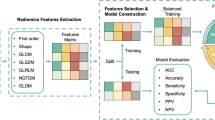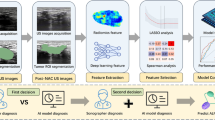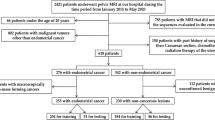Abstract
This study aimed to develop a model based on radiomics and deep learning features to predict the ablation rate in patients with adenomyosis undergoing high-intensity focused ultrasound (HIFU) therapy. A total of 119 patients with adenomyosis who received HIFU therapy were retrospectively analyzed. Participants were included in the training and testing queues in a 7:3 ratio. Radiomics features were extracted from T2-weighted imaging (T2WI) images, and VGG-19 was used to extract advanced deep features. An ensemble model based on multi-model fusion for predicting the efficacy of HIFU in adenomyosis was proposed, which consists of four base classifiers and was evaluated using accuracy, precision, recall, F-score, and area under the receiver operating characteristic curve (AUC). The predictive performance of the combined model combining radiomics and deep learning features outperformed the radiomics and deep learning feature models alone, with accuracy of 0.848 and 0.814 in training and test sets, and AUC of 0.916 and 0.861, respectively. Compared with the base classifiers that make up the multi-model fusion model, the fusion model also exhibited better prediction performance. The fusion model incorporating both radiomics and deep learning features had certain predictive value for the ablation rate of adenomyosis under HIFU therapy and could help select patients with adenomyosis who would benefit from HIFU therapy.






Similar content being viewed by others
Data Availability
The data that support the findings of this study are available from the corresponding author upon reasonable request.
References
Chapron C, Vannuccini S, Santulli P, et al.: Diagnosing adenomyosis: an integrated clinical and imaging approach. Hum Reprod Update 26:392-411, 2020
Stanekova V, Woodman R J, Tremellen K: The rate of euploid miscarriage is increased in the setting of adenomyosis. Hum Reprod Update 3: hoy011, 2018
Sudderuddin S, Helbren E, Telesca M, et al.: MRI appearances of benign uterine disease. Clin Radiol 69:1095-1104, 2014
Dueholm M: Minimally invasive treatment of adenomyosis. Best Pract Res Clin Obstet Gynaecol 51:119-137, 2018
Buggio L, Dridi D, Barbara G: Adenomyosis: impact on fertility and obstetric outcomes. Reprod Sci 28:3081-3084, 2021
Younes G, Tulandi T: Conservative surgery for adenomyosis and results: a systematic review. J Minim Invasive Gynecol 25:265-276, 2018
Yao R, Hu J, Zhao W, et al.: A review of high-intensity focused ultrasound as a novel and non-invasive interventional radiology technique. J Interv Med 5:127-132, 2022
Yu J, Jiang L, Su X, et al.: Comparison efficacy of ultrasound-guided HIFU for adenomyosis-associated dysmenorrhea with different signal intensity on T2-weighted MR imaging. J Obstet Gynaecol Res 49:1189-1197, 2023
Keserci B, Duc N M: Magnetic resonance imaging features influencing high-intensity focused ultrasound ablation of adenomyosis with a nonperfused volume ratio of \(\ge\) 90% as a measure of clinical treatment success: retrospective multivariate analysis. Int J Hyperthermia 35:626-636, 2018
McCague C, Ramlee S, Reinius M, et al.: Introduction to radiomics for a clinical audience. Clin Radiol 78:83-98, 2023
Li H, Gao L, Ma H, et al.: Radiomics-based features for prediction of histological subtypes in central lung cancer. Front Oncol 11:658887, 2021
Sabouri M, Hajianfar G, Hosseini Z, et al.: Myocardial Perfusion SPECT Imaging Radiomic Features and Machine Learning Algorithms for Cardiac Contractile Pattern Recognition. J Digit Imaging 36:497-509, 2023
Qi L, Lu X, Shen H, et al.: Automatic Classification of Mass Shape and Margin on Mammography with Artificial Intelligence: Deep CNN Versus Radiomics. J Digit Imaging 1-9, 2023
Zhou H, Dong D, Chen B, et al.: Diagnosis of distant metastasis of lung cancer: based on clinical and radiomic features. Transl Oncol 11:31-36, 2018
Taleie H, Hajianfar G, Sabouri M, et al.: Left Ventricular Myocardial Dysfunction Evaluation in Thalassemia Patients Using Echocardiographic Radiomic Features and Machine Learning Algorithms. J Digit Imaging 1-13, 2023
Barabino E, Rossi G, Pamparino S, et al.: Exploring response to immunotherapy in non-small cell lung cancer using delta-radiomics. Cancers 14:350, 2022
Sundar S, Sumathy S. Transfer learning approach in deep neural networks for uterine fibroid detection. Int J Computational Science and Engineering 25:52-63, 2022
Dai M, Liu Y, Hu Y, et al.: Combining multiparametric MRI features-based transfer learning and clinical parameters: application of machine learning for the differentiation of uterine sarcomas from atypical leiomyomas. Eur Radiol 32:7988-7997, 2022
Mohammad F, Al Ahmadi S.: Alzheimer’s Disease Prediction Using Deep Feature Extraction and Optimization. Mathematics 11: 3712, 2023
Dey N, Zhang Y D, Rajinikanth V, et al.: Customized VGG19 architecture for pneumonia detection in chest X-rays. Pattern Recognit Lett 143: 67-74, 2021
Gong C, Wang Y, Lv F, et al.: Evaluation of high intensity focused ultrasound treatment for different types of adenomyosis based on magnetic resonance imaging classification. Int J Hyperthermia 39:530-538, 2022
Li J, Wang W, Liao L, et al.: Analysis of the nonperfused volume ratio of adenomyosis from MRI images based on fewshot learning. Phys Med Biol 66:045019, 2021
Kibria H B, Matin A: The severity prediction of the binary and multi-class cardiovascular disease– A machine learning-based fusion approach. Comput Biol Chem 98:107672, 2022
He W, Shi Z, Liu Y, et al.: Feature Fusion Classifier With Dynamic Weights for Abnormality Detection of Amniotic Fluid Cell Chromosome. IEEE Access 11:31755-31766, 2023
Funding
This work was supported by the grants from the Shanghai Science and Technology Innovation Action Plan (No. 22S31903700) and grants from Shanghai Hospital Development Center-United Imaging Joint Research & Development Plan (No. 2022SKLY-12).
Author information
Authors and Affiliations
Corresponding authors
Ethics declarations
Competing Interest
The authors declare no competing interests.
Additional information
Publisher's Note
Springer Nature remains neutral with regard to jurisdictional claims in published maps and institutional affiliations.
Rights and permissions
Springer Nature or its licensor (e.g. a society or other partner) holds exclusive rights to this article under a publishing agreement with the author(s) or other rightsholder(s); author self-archiving of the accepted manuscript version of this article is solely governed by the terms of such publishing agreement and applicable law.
About this article
Cite this article
Ying, J., Jing, X., Gao, F. et al. Prediction of Ablation Rate for High-Intensity Focused Ultrasound Therapy of Adenomyosis in MR Images Based on Multi-model Fusion. J Digit Imaging. Inform. med. (2024). https://doi.org/10.1007/s10278-024-01063-4
Received:
Revised:
Accepted:
Published:
DOI: https://doi.org/10.1007/s10278-024-01063-4




